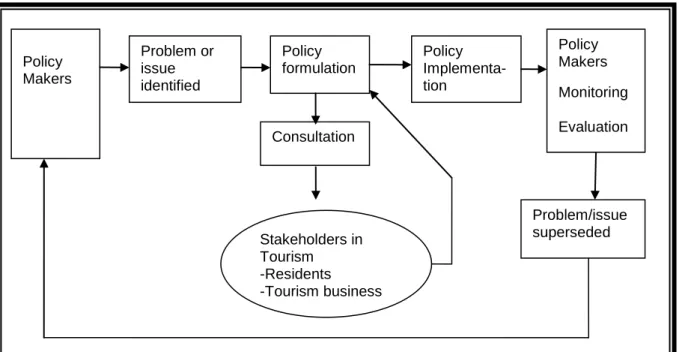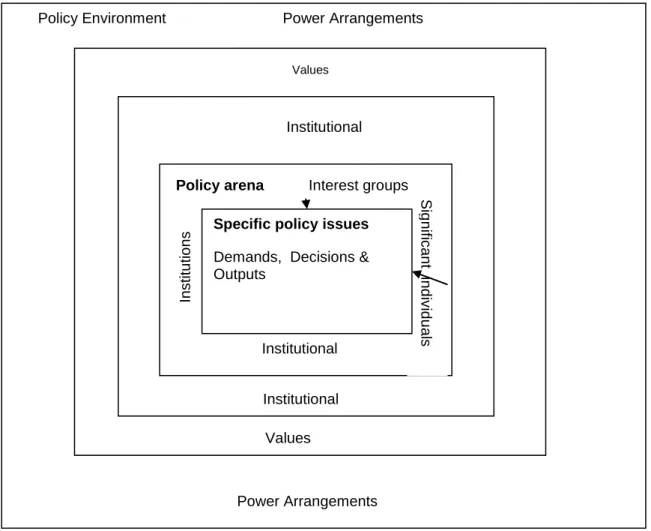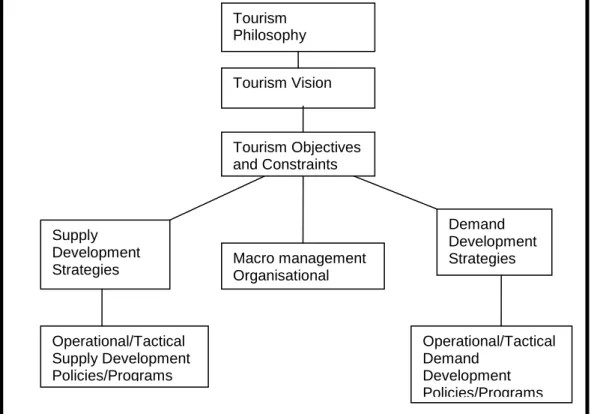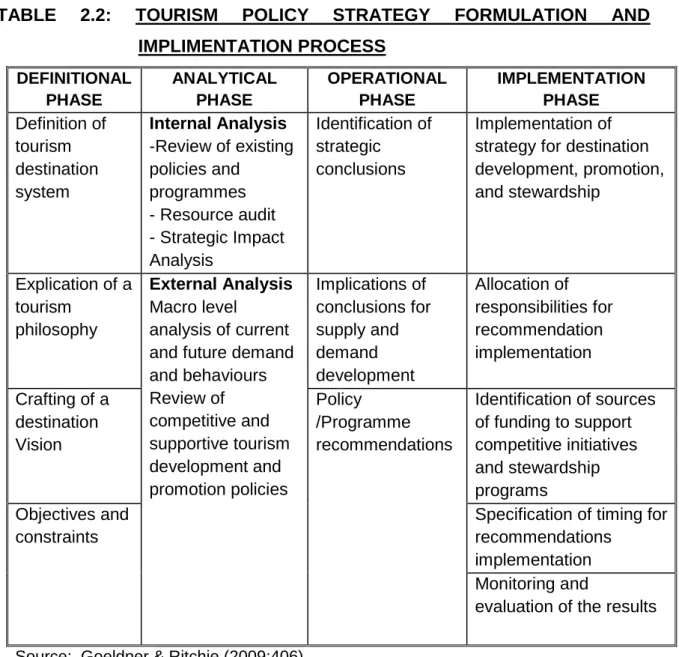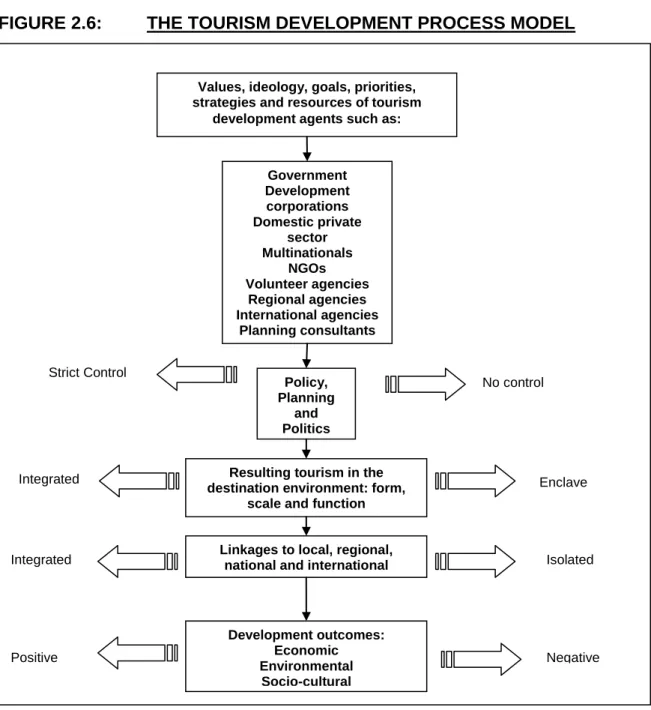To analyze the gaps in the legislative framework governing tourism development in KwaZulu-Natal and how these affect the creation of an enabling environment for coordinated planning in the tourism industry. The study was conducted as applied research and developed a conceptual model for tourism planning and management in KwaZulu-Natal, which is a new model that adds to the body of knowledge in tourism policy and planning.
CONCEPTUAL FRAMEWORK FOR POLICY, PLANNING AND
MODELLING OF PLANNING AND POLICY DEVELOPMENT
CASE STUDIES: POLICY, PLANNING AND PRACTICE 161
DATA ANALYSIS AND INTERPRETATION 184
TOWARDS A CONCEPTUAL MODEL FOR TOURISM
SUMMARY, CONCLUSIONS AND RECOMMENDATIONS 274
INTRODUCTION
Globalization has also forced South Africa and KwaZulu-Natal to become a global player in the tourism industry. The tourism industry in emerging South Africa and KwaZulu-Natal in particular was not immune to the global economic recession in 2009.
BACKGROUND TO THE PROBLEM
The province of KwaZulu-Natal needs to recognize its competitive advantages and bring all stakeholders together towards a common tourism development agenda. Tourism planning in KwaZulu-Natal needs to be aligned with the National Tourism Sector Strategy as a comprehensive tourism plan in South Africa.
STATEMENT OF THE PROBLEM
There is also no provincial strategy that provides guidelines for the formation, composition and functioning of the community tourism organisations. The industry thus remains untransformed without proper planning mechanisms to ensure transformation of the sector.
DELIMITATION OF THE STUDY
- Geo-spatial delimitation
- Conceptual delimitation
The tourism concepts examined in the study are crucial in achieving a coordinated tourism development approach in the province of KwaZulu-Natal. The study looks at different planning perspectives, approaches and models suitable for coordinated destination tourism planning, development and management.
OBJECTIVES OF THE RESEARCH STUDY
To determine the perceptions of tourism stakeholders regarding the effectiveness of the existing policy, institutional frameworks and their implementation in achieving the coordinated development of tourism in the area under consideration. f) Propose mechanisms or models that could be used to ensure coordinated and integrated tourism planning and development in KwaZulu-Natal. The assumptions made in the objectives together form the formula for addressing the main research problem of this study, as these objectives are integral parts of the broader research objective.
STATEMENT OF HYPOTHESIS
The research hypotheses for the study were formulated to give direction to the study according to the geographical and conceptual delimitation of the investigated issues. The study's hypotheses were subjected to a rigorous hypothesis testing exercise during data analysis and interpretation.
ASSUMPTIONS
Second, some officials may serve in more than one tourism coordinating structure in the province of KwaZulu-Natal, which may be annoying for them to participate in the same research for a variety of issues. The assumption was also proven true, as most municipal and provincial officials served in more than one tourism coordinating structure, but they were willing to participate in the research.
SIGNIFICANCE OF THE STUDY
The study provides different perspectives and insights from a wide range of tourism stakeholders, including public sector tourism leaders, tourism industry captains and municipal role players. The analysis of institutional frameworks and inherent organizations that govern tourism in KwaZulu-Natal is crucial to ensure an inclusive tourism planning and development of the tourism industry in the province.
DEFINITION OF TERMS
- Tourism
- Planning
- Tourism Policy
- Strategic Tourism Planning
- Coordination
- Competence
- Literature Review
- Plagiarism
- Falsification of results
This is a narrow statistical definition of tourism and does not cover all aspects that should be investigated and integrated in the planning, development, coordination and management of the tourism industry. Generally, Planning can be defined as, "the basic element of management that predetermines what an organization proposes to achieve in the changing environment in which it exists". (Bennett, 2002: 35).
CONCLUSION
All sources of primary and secondary information used during the study have been duly identified in the text and included in the reference list at the end of the study. The idea of participating in tourism planning, management and development in the areas of study of KwaZulu-Natal provides first-hand experience and legitimization of the need to understand and implement tourism planning and management.
INTRODUCTION
KEY PLAYERS IN TOURISM POLICY, PLANNING AND MANAGEMENT
- Tourists
- The host community
- Government Agencies
- The Tourism Industry
- Purpose of Tourism Policy
- Importance of Tourism Policy
- Areas Addressed by Tourism Policy
- Tourism Policy Making Process
Tourism policy represents an amalgamation of the principles on which a rural approach to tourism is based (Sinha, 2005). The model presented above shows a generic tourism policy structure that could be adapted for KwaZulu-Natal as a tourism destination.
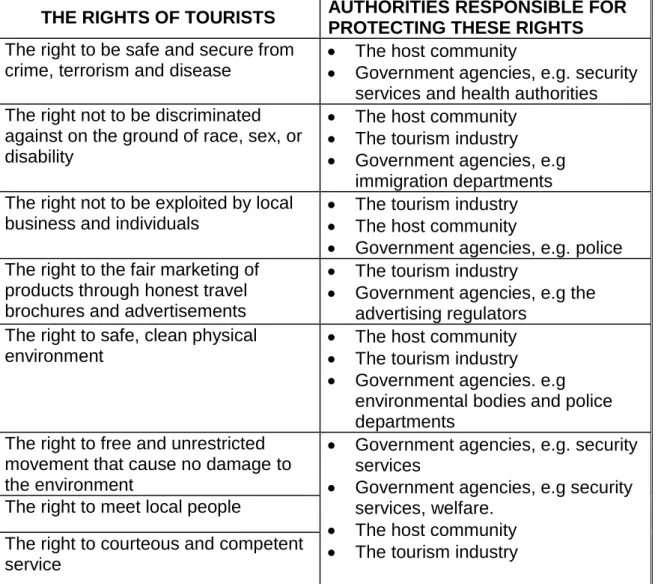
TOURISM PLANNING
- Significance of Tourism Planning
- The Tourism Planning Process
Tourism planning requirements and state intervention in the development process are usually a response to the unwanted effects of tourism development at the local level. Tourism planning is extremely important if we want to avoid the negative impacts of tourism development (Borges et al, 2011:11).
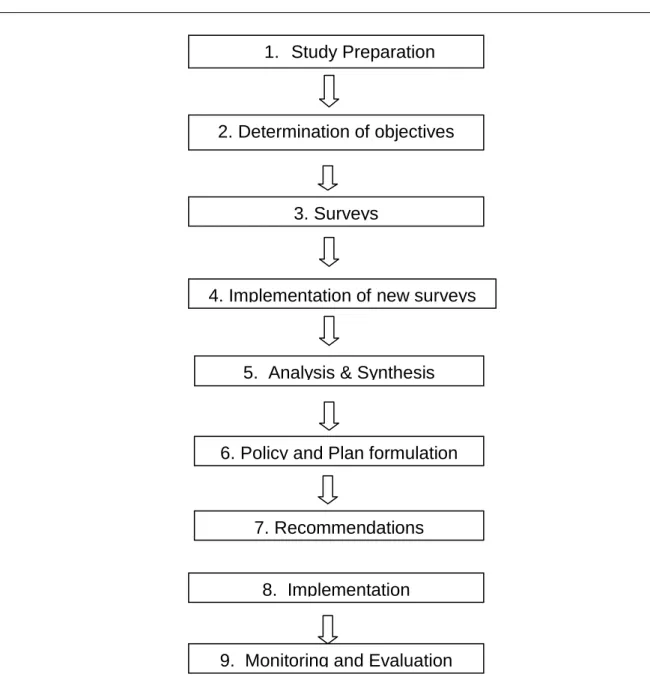
Survey of Existing Data
Preserve cultural and natural resources as part of tourism development and facilitate this through architectural and landscape design that reflects local traditions. Authorities should implement a long-term data improvement strategy by collecting new data as it becomes available and covering issues not necessarily identified in the current strategy.
Analyses
The possible sources of funding for the development are investigated and the appropriate level of foreign funding (if any) is calculated. Analyzes should also examine the risks involved and the sensitivity of the results to changing assumptions.
Policy and Plan Formulation
The impact analysis should be comprehensive and cover issues such as the likely impact the development will have on the host community and the environment, economic implications in terms of key indicators (employment, income, government revenue and foreign exchange flows) and likely economic rates of return. Equally crucial is the inclusion of a forecast model so that future economic, environmental and social impacts can be assessed.
Recommendations
At this stage, feedback between the authorities and the development plan team is essential to focus attention on issues that need attention and to reduce areas where it is not. Therefore, the recommendation development phase should really be seen as a period of dialogue between the planning team and policy makers.
Implementation of the Plan
Monitoring and Evaluation
Boosterism
Boosterism is a simplistic view that tourism development is inherently good and automatically beneficial to the host community. According to this approach, little attention is paid to the possible negative economic, social and environmental impacts of tourism and instead, cultural and natural resources are considered as objects to be exploited for the sake of tourism development (Hall & Page, 2006:22 ) In many ways. Boosterism can be more aptly described as a form of non-planning.
The Economic Tradition: Tourism as an Industry
According to Getz (1987: 10), boosterism is still, and always will be, practiced by two groups of people; politicians who believe philosophically or pragmatically that economic growth should always be promoted; and by others who will benefit financially from tourism. Boosterism seems to be the process that cannot be adapted to KwaZulu-Natal, as the tourism industry in this province is too diverse and contains elements of ecotourism based on sensitive natural environments that require a careful balance between tourism development and conservation.
The Land Use/ Physical/ Spatial Approach
Significantly, when social and environmental issues are examined, they are examined from an economic framework, that is, they are treated as externalities rather than within frameworks such as rights or welfare (Hall & Brown, 2002).
Community-Oriented Tourism Planning Approach
Sustainable Tourism Planning Approach
This approach to tourism focuses on involving communities in the planning and development process and on developing the types of tourism that create benefits for local communities. It uses techniques to ensure that most of the benefits of tourism development accrue to local residents rather than foreigners.
Cooperative and integrated control systems
However, quality tourism requires a quality product and sufficient quality tourists to meet expected arrivals and spending targets (Bramwell, 2004: 336).
Development of industry coordination mechanism
Guangrui et al say that to improve the development of the tourism industry, it is necessary to build a government-led tourism coordination mechanism and related organizations, domestically and internationally. Therefore, it becomes imperative that government, at all levels, use its influence to encourage greater operational coordination for planning issues by creating structures and processes that enable stakeholders to talk to each other and create effective relationships and partnerships (Elcock, 2002 ; Huybers, 2007). Guangrui et al 2011).
Raising Producer Awareness
Support by industry groups of voluntary development codes, environmental codes or codes of conduct is perhaps an indication of possible directions if common needs can be agreed upon. This approach can help bring together the private and public sectors in KwaZulu-Natal to ensure a coordinated tourism planning and development approach that addresses aspirations of both government and industry and improves destination competitiveness.
Strategic tourism planning to supersede conventional approaches
Provides a baseline for the continuous monitoring of the progress of tourism development and keeps it on track. Coordinating the fragmented nature of tourism (especially in relation to accommodation, transportation, transport, marketing and human resources).
Role of Government in Tourism Planning
- Coordination
- Planning
- Policy, Legislation and Regulation
- Government as entrepreneur
- Stimulation
- Tourism promotion
- Social tourism
- Government as public interest protector
The level of government regulation of tourism tends to be a major issue for the various components of the tourism industry (Shaw & Williams 2004). The role of the state as entrepreneur in tourism development is closely related to the concept of the devaluation of capital.
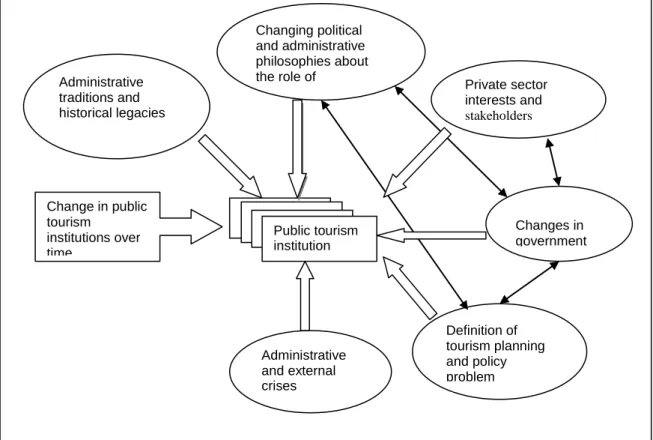
Tourism Planning as an Integrated System
Bennett (2002) further elaborates that the demand drivers are international and domestic tourist markets and local residents using the tourist attractions, facilities and services. According to Bennett et al. (2006), tourism supply factors include tourist attractions and activities, accommodation and other tourist facilities and services.
TOURISM DEVELOPMENT
- Influences on Destination Development Decisions
- Tourism Development Process
A number of stakeholders in tourism that must be taken into account in the development of tourism in a destination are also shown in Figure 2.6. The information gathered from the literature puts into perspective the many tourism policies and plans governing tourism in KwaZulu-Natal.
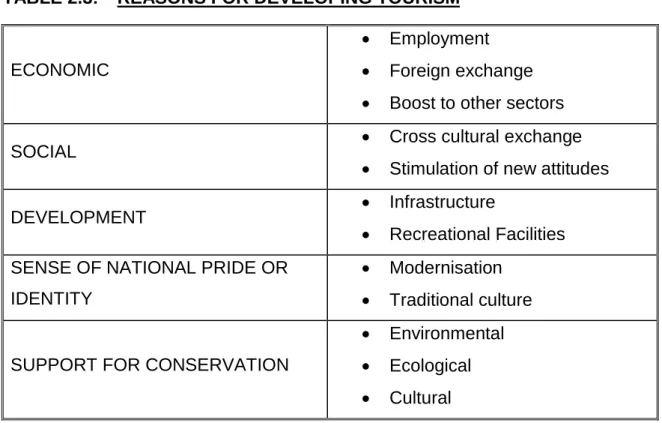
INTRODUCTION
Tourism planning and policy research can be built on two main types of theory, that is, prescriptive models and descriptive models (Mitchell 1989). On the other hand, descriptive approaches give rise to explanations about what happened during the decision-making, planning and decision-making process.
MODELS OF TOURISM PLANNING AND DEVELOPMENT
- Regional Tourism Planning Model
- Visitor Demand Model
- Planning as a Conceptual System
- Community Tourism Development Planning Model
- Environmental Tourism Planning Model
- Models of Tourism Travel
All tourism plans at provincial and municipal level must take into account all interrelated elements of the tourism sector. KwaZulu-Natal tourism industry policy development and planning is expected to be based on understanding internal and external influences shaping tourism movements.
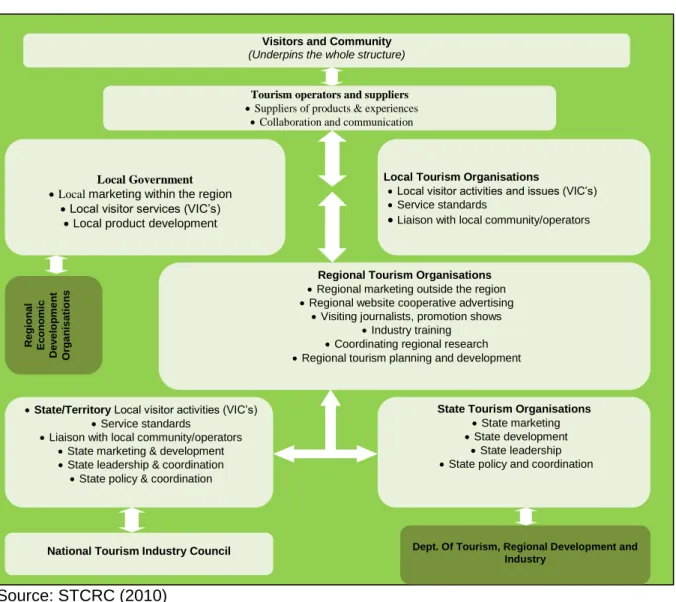
MODELS OF HUMAN RESOURCES PLANNING AND MANAGEMENT FOR TOURISM ORGANISATIONS
- The Michigan Model
- The Harvard Model
- The Warwick Model
The following three workforce management models that can be adopted by tourism organizations are (Bennett et al, 2006). The Michigan Model links Human Resource practices and business requirements with an emphasis on resources.
CONCLUSION
The Warwick model becomes less prescriptive in terms of determining what needs to be done, as what is best for one organization will not necessarily be best for another. The government seems to be at the forefront of tourism policy and planning that promotes development.
INTRODUCTION
This chapter also shows how tourism development in KwaZulu-Natal does not reflect population dynamics in the province. The aim is to provide an overall picture of the province and the context in which tourism policy, planning, development and management take place.
PHYSICAL LOCATION OF KWAZULU-NATAL
In the context of this study, the spatial delimitation of the province of KwaZulu-Natal into district and local municipalities has tremendous implications for institutional frameworks in relation to how tourism policy, planning, development and management take place. The significance of the geographical demarcation of KwaZulu-Natal to political jurisdictional boundaries is decisive in the delivery of tourism services by different spheres of government in accordance with the constitution of South Africa.
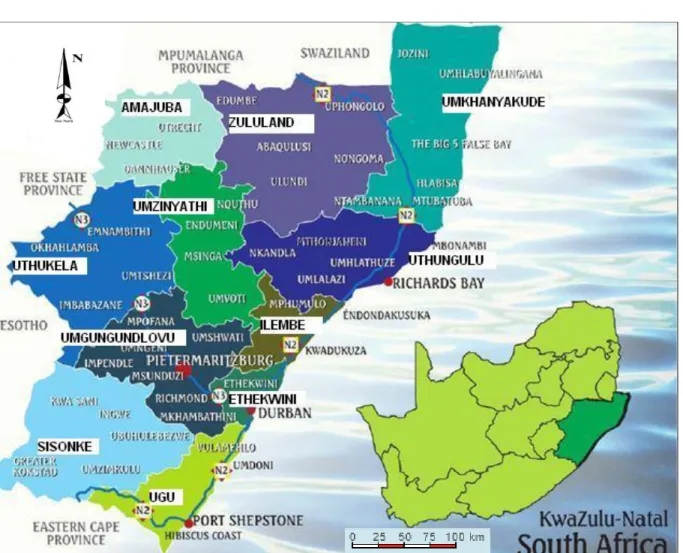
TOURISM DESTINATIONS OF KWAZULU-NATAL
Of relevance to the role of municipalities, it is worth noting that a member of the executive council of a province may delegate any power or function to be exercised or performed under an Act of Parliament or a provincial law to a municipal council. The provisions of the constitution set the limits of what each sphere of government is responsible for in relation to tourism.
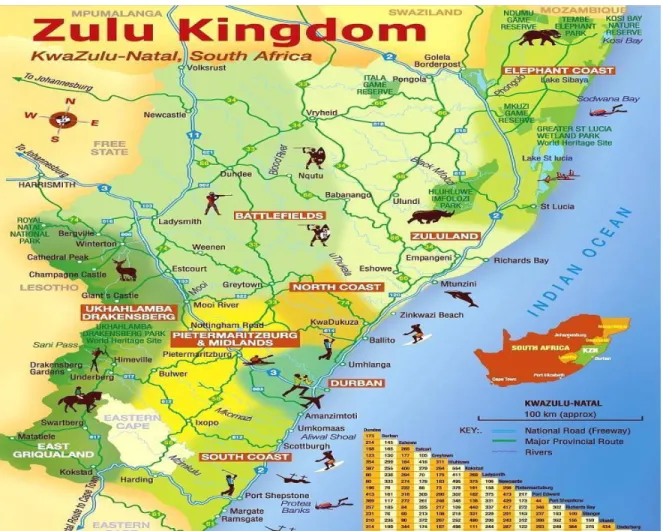
DEMOGRAPHIC ATTRIBUTES OF KWAZULU-NATAL
It is expected of the incumbent government and all public entities entrusted with the responsibility of planning and coordinating tourism in KwaZulu-Natal to ensure that tourism benefits all citizens of the province and that there is an equitable geographical spread of tourism development throughout the province (budget policy). Speech But tourism is still not transformed in KwaZulu-Natal with an undetermined small percentage of tourism businesses belonging to black new businesses and a large number of businesses still belonging to the white owned established businesses.
WEATHER AND CLIMATE
In the Drakensberg, the cool towns of Bergville and Winterton offer a refreshing break from the storm [http://www.southafrica.com/kwazulu-natal/climate, (2010)]. The importance of weather and climate in this study is that KwaZulu-Natal is endowed with good weather and climate attributes, and tourism planners and marketers are expected to use these aspects and reflect them in tourism plans and marketing strategies for advantageously positioned KwaZulu-Natal. compared to destinations with similar attributes.
TOPOGRAPHY
The region along the Indian Ocean is extremely narrow in the south and widens in the northern part of the province. Third are the two mountainous areas, the Drakensberg Mountains in the west and the Lebombo Mountains in the north.
HISTORY AND CULTURE
The Tugela falls some 2,000 m over the edge of the Mont-aux-Sources plateau in spectacular style, forming the second highest waterfall in the world [http://www. In the context of this study, it is important for tourism policy makers, planners and marketers to consider the topographic physical features of the province that have endowed KwaZulu-Natal with picturesque natural attractions that differentiate this province from other comparable destinations, especially for the domestic ones. market.
ECONOMIC-SPATIAL PLANNING IN KWAZULU-NATAL
- Provincial Spatial Economic Development Strategy 2006 (PSEDS)
- Transport and Logistics Infrastructure
To facilitate the increased growth of existing centers and corridors of economic development in the province; and. The provincial government is expected to facilitate development for tourism projects identified in the priority corridors.
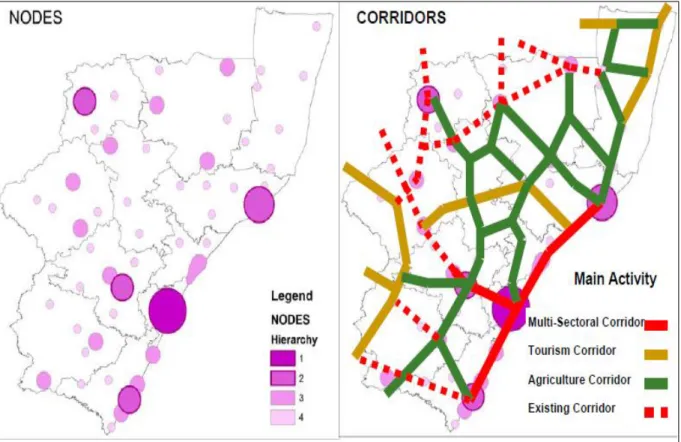
REQUIRED TOURISM RELATED SERVICES
- Renewable Energy
- Water
- Cellular Mobile Phones
- Internet and E-mail
- Durban Information Communications Technology
- Postal Services
Despite recent price increases, electricity costs in South Africa are still among the lowest in the world. South Africa is one of the few countries in the world where municipal tap water is completely safe to drink.
STATE OF THE ECONOMY AND INFLUENCE ON TOURISM
Based in Durban South Africa, SmartXchange, an Information Communication Technology (ICT) incubator has been set up in Durban as part of the city's drive to build a globally competitive ICT industry. The initial focus has been on areas of the KwaZulu-Natal province, however, it is envisaged that the model can be replicated in any other part of the country.
CONCLUSION
The chapter also indicated a number of tourism-related services available in KwaZulu-Natal that need to be manipulated for the benefit of the tourism industry. Some of these initiatives include funding avenues to be fully explored by tourism practitioners across the province to allow local communities to take advantage of the state's financial provisions.
INTRODUCTION
The applied research adopted in this study used a two-pronged approach, namely, qualitative and quantitative research methods. It is therefore an honest assumption, in this study, that the knowledge developed through this applied research will add to the existing body of knowledge and contribute to better tourism planning and development in KwaZulu-Natal.
THE QUALITATIVE AND QUANTITATIVE RESEARCH METHODS
- Qualitative Research Methods in Tourism Planning
- Quantitative Research Methods in Tourism
Three additional important qualitative research developments are triangulation, hybridization and the linking of qualitative and quantitative research (Flick, 2006). Numerous quantitative research methods are used in the field of tourism studies (Weaver & Lawton, 2006).
RATIONALE FOR USING QUALITATIVE AND QUANTITATIVE RESEARCH METHODS IN THE STUDY
Quantitative Methods are used to embellish a primarily Qualitative Study
Qualitative methods are used to help explain Quantitative findings Model 1: Qualitative methods are used to help develop quantitative
Qualitative and Quantitative Methods are used equally
RESEARCH DESIGN
- Research sample design, sampling and sample size
There are a myriad of government entities dealing with various aspects of tourism in the province of KwaZulu-Natal. The province of KwaZulu-Natal has a number of statutory tourism co-ordinating structures set out in the KwaZulu-Natal Tourism Development and Promotion Policy (2008).
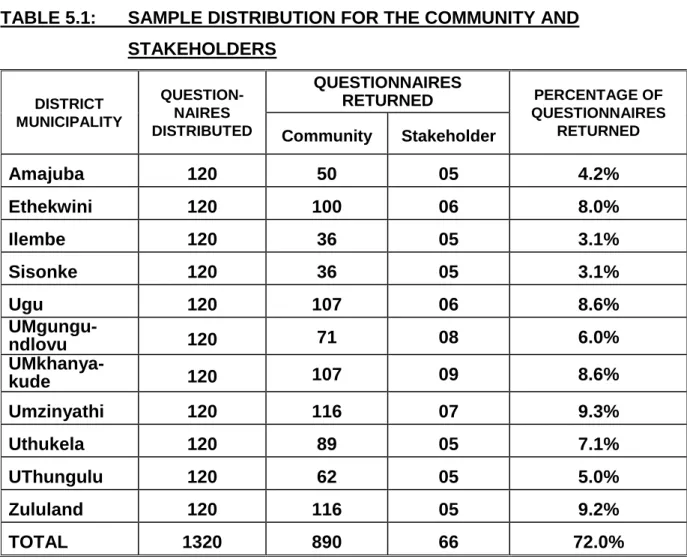
DATA COLLECTION
- Pilot Study
As part of this study, the Delphi technique was modified to include a set of only two rounds. The pilot study also suggested surveying all public entities involved in tourism in the province.
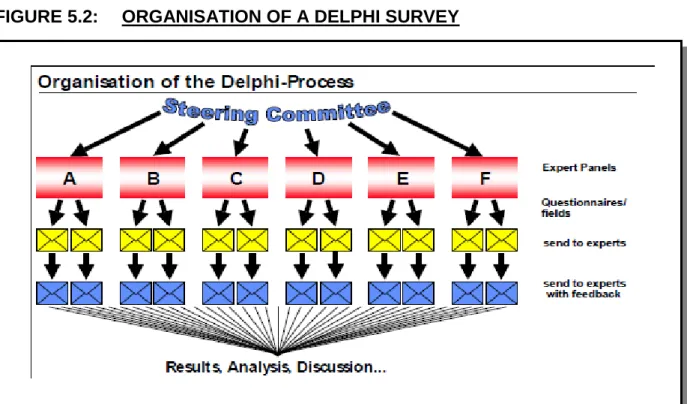
DATA ANALYSIS AND INTERPRETATION
The research assistants were then trained in the research ethics, content and language of the questionnaire. It is important to distinguish between the research hypotheses and statistical hypotheses as they were designed and tested in this study.
CONCLUSION
Analysis and interpretation of the data also led to the development of a new model in Chapter Nine, which addresses the coordination of tourism activities on how tourism policy, planning and management can be inclusive for communities in KwaZulu-Natal.
INTRODUCTION
THE TOURISM DEVELOPMENT AGENCY APPROACH
- Ugu District Municipality
- Rationale for the Development Agency Approach
- Effectiveness and policy alignment
- UMkhanyakude District Municipality
- Missed opportunity
The Ugu District Municipality has established Ugu South Coast Tourism (Pty) Ltd as a Municipal Entity as contemplated by Section 86B of the Local Government Municipal Systems Act (Act 32 of 2000). UMkhanyakude District Municipality is located in the North Eastern corner of KwaZulu-Natal (KZN) South Africa.
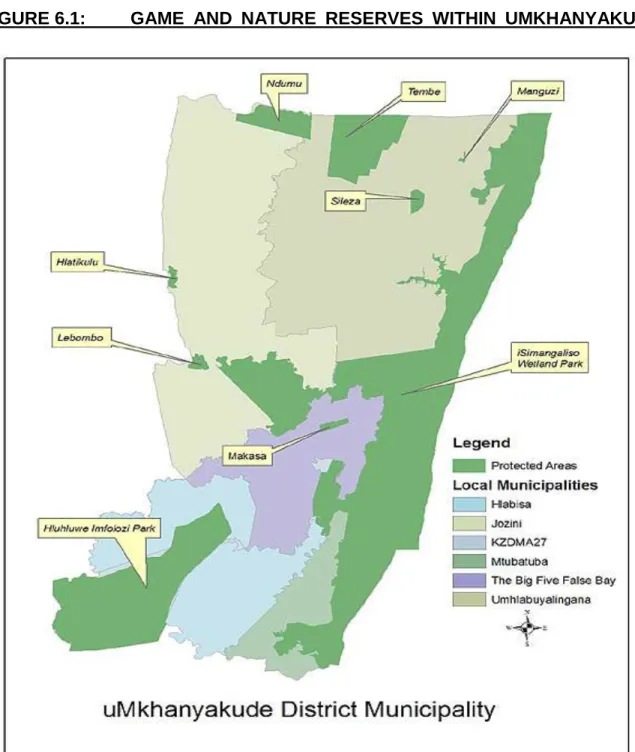
DISTRICT MUNICIPALITY TOURISM PLANNING APPROACH
- Tourism Attributes of UMgungundlovu District Municipality
- Effectiveness of the District Municipality Tourism Planning Approach
UMgungunndlovu Municipality coordinates all tourism functions within the district and as such is expected to have a District Tourism Forum (DTF). The absence of the District Tourism Forum at district level means that there is no coordination of tourism activities at district level within the district municipality of UMgungunndlovu (DEDT, 2011).
